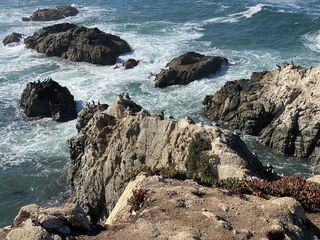Environment
A Daycation to Challenge Pandemic Blues
Finding restorative nature near you.
Posted November 1, 2020

Are you within a two-hour drive of some eye-popping scenery? Fall foliage is a visual delight in much of the U.S. right about now. If you’re in the Northeast, maple syrup will soon be running and tapped. Or maybe it’s snowcapped mountains in the Rockies that capture your attention and define your late autumn sky. Perhaps the cooler days in the Southern states are a prelude to autumn’s bounty. Here in Northern California, seasonal change is minimal but it’s always the perfect time for me to visit the always-dramatic wild and rugged north coast.
While COVID-19 runs rampant through much of the country and makes life difficult at every turn, the great outdoors offers both protection from crowds and enough enchantment to make life seem sane and normal, if only for a few hours. And nature has soothing and health-giving qualities well documented in the psychology journals.
A journey of any kind can serve as a conduit for emotional relief, recovery, and new growth. Therapeutic travel can take you far away or work just as effectively close to home. A meditative walk, while not what we usually think of as travel, might help clear a troubled mind and reduce non-productive worry (meaning worrying about something over which you have no control).
According to Buddhist philosophy, the beginner’s mind is a state of wonder and curiosity lost to many of us when we emerge from childhood. It relies on openness to experience not colored by our own expectations, preconceived notions, or stereotypic ideas. Think about how a young child approaches a new experience. It’s with an open and inquisitive mind, and without biases or goals. While not a permanent solution, it might just have some benefits like slowing your pulse, deepening your breath, and momentarily shifting your attention. Perhaps this time-out will be recuperative enough to recalibrate your internal thermostat so that you can tolerate another day of isolation or family chaos.
Nature is therapeutic, comforting, and plentiful even in big cities. Parks are everywhere and the trees they house offer all kinds of comfort. Metaphorically, a tree is a nurturing mother offering a resting place, providing shade, sometimes fruit, and foliage that creates unique and interesting patterns of light in any breeze. Trees offer a reminder of a life force that’s steady, sturdy, and yet ever-changing. In fact, we humans share a great deal of a tree’s DNA. Unlike most other living organisms, trees are especially long-lived. Ancient redwoods have presided over the forests near me for more than two thousand years. It reminds us that life goes on and there will be life after COVID-19.
The days to come are unknowable and unpredictable. But even when the past and future seem bleak, now can hold meaning and pleasure. Stay with the present—today or sometime this week or this month. It is the only time that is available for experiencing anything. Find a good time to get away, even a half-day will do. Finding freshness in everyday life requires only a change in perception, in what you focus on. Leave your home but you don’t need to go far to do something rejuvenating.
I took my own advice and within a two-hour drive I arrived at Bodega Head. This landmass juts out into the Pacific Ocean and forms the northern tip of what is known as Bodega Bay. The southern tip includes Tamales Bay, about 30 miles north of the Golden Gate Bridge. If you’re not familiar with the climate here, you might imagine it pleasurable to swim in the bay in the summer months, but locals would advise against it and instead recommend wearing a wet suit because the water is frigid year-round. Summers are foggy, cold, and windy while autumn is perfectly wonderful, warm and generally sunny. But the surf can be treacherous at any time which is why a tall lighthouse sits atop Bodega Head warning ships of outcroppings and dangerous undertows with lights and fog horn. Many a boat has been sacrificed to the whim of the ocean here.

Still, the place is majestic and I can never get enough. I return time and again. I don’t know whether it was the smell of the briny sea, the sound of the rhythmic waves crashing against rocks, the taste of the salty mist carried in the wind, the visual show of ever-changing patterns of light and water, or the call of the seagulls and sea lions sunbathing on nearby bluffs—maybe as curious about us visitors as we were about them. But the show was well worth the price of admission—simply following COVID-19 safety rules: distancing from fellow travelers, wearing masks when appropriate, and generally showing respect to the people who share the moment and the great outdoors.
As if in still-shots, couples holding hands, singles with cameras poised for the right angle, each grouping paused to view the spectacle of their choosing like a choreographed dance. A unique COVID element was apparent. I hadn’t observed this on previous visits. Everyone seemed acutely aware of their body in space, a necessity to maintain the required six feet from everyone else.
Hikers, one by one, traversed the narrow paths that crisscross the headlands. A pair of shoes with good traction was the only requirement necessary to amble around the cliff tops safely. But even if ambulation is beyond your current ability, your car can deliver you to a flat spot where photo opportunities surround you in every direction.
Though not much of a journey really, rather an outing to a familiar and well-loved spot, it delivered the pleasure I craved. A two-hour journey into a restive spot can serve as a conduit for emotional relief, recovery, and new growth. Most of all it’s a timeout from the pandemic blues. While a day trip won’t change your life, you just might feel refreshed, look at things differently, and have new appreciation for Mother Nature’s bounty.
This article is based on some themes from the author’s most recent book, Inward Traveler: 51 Ways to Explore the World Mindfully, 2018.




